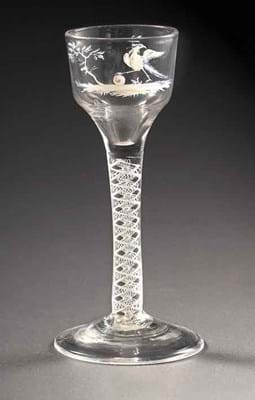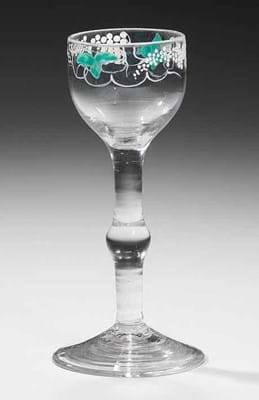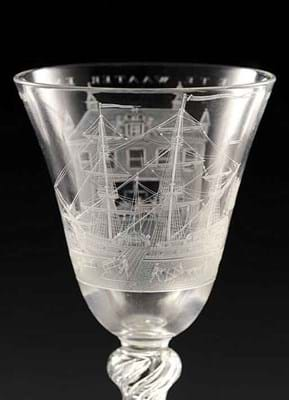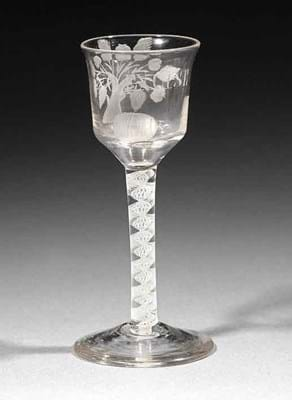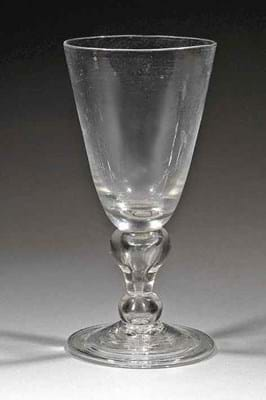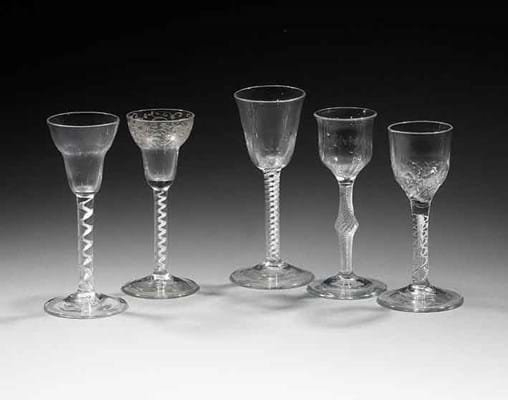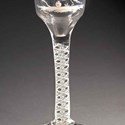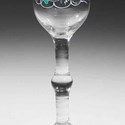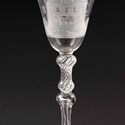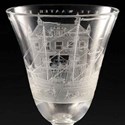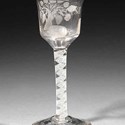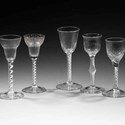With a 267-lot single-owner morning session and a 215-lot mixed-vendor afternoon sale on June 4, it was a sizeable splash to kick off the first of what are to be bi-annual dedicated glass sales in their flagship ceramics department.
Bonhams' higher profile in this field is largely due to the arrival of Simon Cottle from Sotheby's where he was glass specialist for around a dozen years. And for the glass collecting world at large their bigger input must be welcome.
With the other two London rooms operating a minimum lot value and a mixed-furnishing approach to the decorative arts, both Sotheby's and Christie's appear to have largely abandoned the prospect of stand-alone glass sales.
English glass dominated this event, accounting for just over three-quarters of the content. This was largely because the morning session was devoted to English pieces from the collection of Ron Thomas, who specialised in 18th century drinking glasses.
But the Continental market overall is also softer, with fields like early (pre-19th century) Germanic glass struggling to sell at all, so this was a field where less is being offered or considered for sale.
English Drinking Glasses
Though it may lack the firework display of its more decorative counterparts, classic 18th century English glass is a much more solid performer. It may not have totally escaped the factors that affect the whole antiques business (dealers buying less for stock and demand focused on the rarest buying opportunities), but it has a broad enough base of home-grown collectors and dealers to be relatively buoyant.
And the Thomas collection sale was enough of an occasion to bring some of the mature and largely dormant buyers out of the woodwork.
Anyone attending the sale would have been struck by the fullness of the saleroom (even allowing for its small size) and by the wide spread of buyers. No fewer than 150 registered to bid for the Thomas collection and as many as 83 were successful, a much higher number than usual.
As a result, selling rates were up to 88 per cent for the Thomas collection and 73 for the mixed-owner sale. And even if not everything wildly outstripped estimate, there was enough competition to provide a grand total of just over £590,000 hammer, with the morning providing £346,200 and the afternoon £243,910.
Wing Commander Ronald Thomas started collecting glass over half a century ago, but is best known to many in the field through his Midsomer Norton shop Somervale Antiques, where he mixed glass with silver and furniture, and for his appearances on the fairs circuit at the likes of Chelsea, Olympia and the LAPADA Fair.
He carried on trading into his early 80s, finally selling his remaining stock at Dreweatt Neate in 2003. But alongside the glass he bought to trade, he amassed his own private collection, which he has now, aged 89, decided to consign to Bonhams for sale.
Amassed seems to be the appropriate word. Few people had seen his private collection before it came to auction and several trade specialists commented on the sheer quantity of glasses it included.
Rather than keeping a small refined personal collection, Ronald Thomas seems to have gone for wholesale representation along study collection lines, so that along with some desirable collectors pieces - early balusters from the first two decades of the 18th century and Beilby-decorated glasses and colour twists of the 1760s - he had plenty of more standard pieces.
Indeed, there was so much (around 1000 pieces in total) that an even larger group of lower-value material will be offered in 300-400 multiple lots at the auctioneers' secondary Knowle rooms later in the year.
So, while it undoubtedly drew collectors out of the woodwork, this was largely a mature audience in every sense of the word. All the main collectors and dealers were represented either in person or absentee form (Delomosne, John Smith, Alan Milford, Christopher Sheppard were all in the audience). Both categories were looking for rarities and special classes of glasswares to fill gaps in their holdings. This accounts for the prevalence of unsolds at the lower end of the scale.
But Simon Cottle felt that the event "needed a certain amount of bulk" and that the inclusion of less expensive glasses offers a London platform for cheaper pieces and an opportunity to encourage entry level buyers.
Anyway the presence of so many buyers and some fresh collecting blood (brought in, said Cottle, by extensive marketing) ensured that there was plenty of competition for those more desirable pieces. These produced some bullish prices to help boost the total.
Of course, all these observations also hold true for the afternoon session, which offered more of the same and more decorative material.
So what did the room and the phones fight over? In the Thomas sale it was the categories cited above plus pieces with unusual engraved or other decoration.
The collection's star was his group of early baluster glasses, several of which were exhibited in the Glass Circle Diamond Jubilee exhibition at Christie's in 1997. Balusters entered the doldrums in the 1980s, revived in the 1990s and have been in demand ever since, and Mr Cottle has noticed a crossover interest from collectors of early sealed bottles.
This was the case here, with notable phone input from America, Australia and the UK helping to push up demand. The most popular at Bonhams were in the 1997 show: a 7in (19cm) high, heavy baluster with an acorn knop stem that was pursued to £8200; the particularly early mammoth size version that made £7500 and the 9in (23cm) high example with a double drop knop to the stem at the same price.
But outstripping them all at £9500 was a 6.25in (16cm) high wine glass that bore a moulded inscription to the solid pedestal stem reading God Save Ye King with a crowned bust flanked by the initials GR.
One of a group of rare Hanoverian glasses made to celebrate the coronation of George I in 1715, this was taken to £9500, comfortably over the estimate and a substantial increase on the £1800 that he paid for it 28 years ago at Sotheby's sale of the Anthony Waugh Collection.
The most expensive of his eight colour twist glasses was predictably that boasting the most desirable canary yellow shade a 6in (15.5cm) example set with opaque white spiral encasing the yellow central thread. This came in at £11,000, a reasonably strong price given there was a footrim chip.
It was followed at £5500 by a slightly smaller glass featuring a purple thread, another rare colour. More surprising, perhaps, was the double-estimate £4000 paid out for an example with a translucent ruby red twist. This is a more common colour, but the price was a reflection, said Cottle, of interest from two of those new collectors rather than established gap-fillers. In the Beilby decorated glasses, his opaque twist stemmed glass, decorated with a peacock resting his foot on a ball flanked by a tree, was again predictably the most expensive, coming in on an upper-estimate £9000 paid by an established collector.
Prices for his three other Beilbys, which had simpler decoration, all kept close to the estimate. A 6in (15cm) high glass painted with a foliate meander made £3800, a 6.75in (17cm) high version with fruiting vine to the trumpet bowl made £3500, and a 6in (15cm) high version with fruiting vine to the opaque bowl took £2200.
Interestingly, all three were dramatically outstripped by a 6in (15cm) Beilby glass in the afternoon mixed-owner sale. In this case, its simple fruiting vine meander was less refined but it boasted two leaves that had been painted in turquoise, one of only two such recorded. This was enough to prompt the same established collector to go to a double-estimate £8000 to secure it, showing just how much store people set by the 'scarcity' factor.
Engraved Glasses
Amongst the specialist engraved glasses there was plenty of demand for the 18th century examples decorated with Jacobite symbols despite the debate about the exact dating of this class of decorated glassware in recent years. But this was an area where there was apparently new collecting interest on the telephones, which were active participants here.
All 16 sold, with several pursued to multi-estimate sums. On the other side of the religious and political coin, a double-estimate £2800 resulted from a four-way contest between three phone bidders and London dealer Christopher Sheppard for a c.1720 Williamite cylinder knopped glass engraved with an equestrian portrait and The Glorious memory of King William III. The 6in (15.5cm) high opaque twist No Excise cider glass shown here was another specialist glass that prospered, selling for £5200 to a collector.
A group of seven Dutch engraved light balusters, a class that has not always performed smoothly at the rostrum, were all snapped up. Competition was principally between the phones and a blonde-haired lady in the room acting as an agent for a collector who bid on most and secured two.
But neither she nor the phones were the successful purchaser of the most expensive example, the 8in (21cm) high version shown on page 10, which was finely engraved, signed and dated 1759 by one of the best-known hands, Jacob Sang, and led the group and the sale on £20,000 when a buyer in the room took it against a commission bid.
Simon Cottle was also pleased with the warm response to the group of later Regency engraved glasses that rounded off the Thomas sale. He guided these cautiously, wary of overpricing, "because it's a market that can be up and down", but these virtually all sold to a mix of trade and private buyers with one or two outstripping those modest guidelines.
Apart from the failures at the lower end, the specialist category that proved least popular was the early 19th century Bristol and Bristol-type tinted and gilded tablewares. This was a field of particular interest to Wing Commander Thomas and Mr Cottle had hoped their colour and decorative nature might broaden appeal. However, the volume may have outstripped demand as the room picked its way through these. His Non-such stands and finger bowls either went below estimate or failed to find a buyer.
Of no fewer than five sets of tinted decanter and cruet sets and single stoppered decanters, two topped estimate, a decanter set in amethyst at £900 and another in green at £950, but the rest either failed or just scraped in.
The buyers premium was 20/12%.

